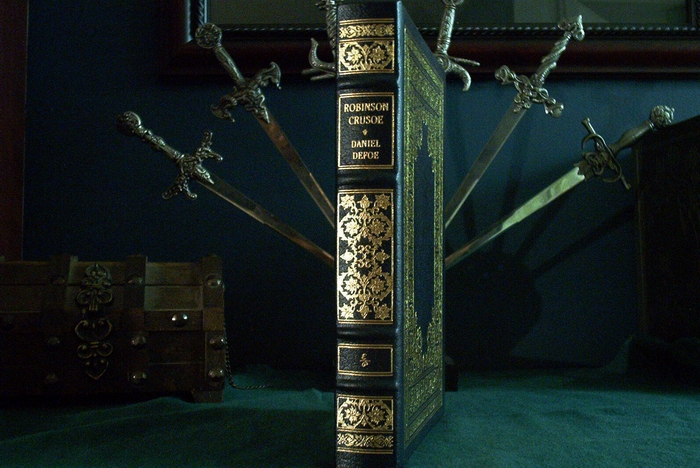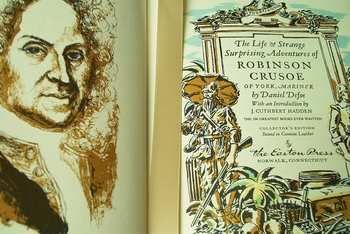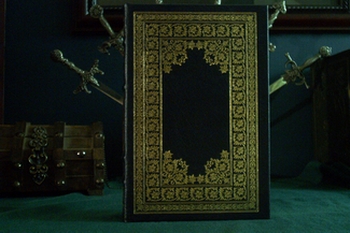Easton Press Daniel Defoe books
Robinson Crusoe - 100 Greatest Books Ever Written - 1976A Journal of The Plague Year - 100 Greatest Books Ever Written - 1978
Moll Flanders - The Collector's Library of Famous Editions - 1983
Franklin Library Daniel Defoe books
Moll Flanders - 100 Greatest Books of All Time - 1978
Moll Flanders - World's Best Loved Books - 1983
Robinson Crusoe - World's Best Loved Books - 1985
Daniel Defoe biography
Daniel Defoe, original surname Foe (1659-1731), was an English journalist and novelist, born in London, and educated in Stoke Newington. He added "De" to his original surname about 1700. He was educated for the Presbyterian ministry, but decided in 1685 to go into business instead. He became a hosiery merchant, and his business gave him frequent opportunities to travel throughout Western Europe. An opponent of The Catholic King James 11, Daniel Defoe took an active part in the rebellion (1685) led by James Scott, Duke of Monmouth, against King James 11. In 1692 Daniel Defoe's business went into bankruptcy, but subsequently he acquired control of a tile and brick factory. He obtained a government post in 1695 and the same year wrote Essay on Projects (1965), a remarkably keen analysis of matters of public concern, such as education of women, highway maintenance, and care of the feeble-minded. Especially noteworthy among his writings during the next several years is the satiric poem The True Born Englishman (1701), an attack on beliefs in racial or national superiority, which was directed particularly toward those Britons who resented the new British sovereign William 111 because he was Dutch. The following year Daniel Defoe published anonymously a tract entitled The Shortest Way with the Dissenters. When Defoe's authorship of the tract was discovered, he was arrested (1703), sentenced to stand in the pillory, and given an indeterminate time in jail. Robert Harley, the Speaker of the House of Commons, secured his release from prison in November, 1704. It is probable that the condition for his release was his agreement to become a secret agent and public propagandist for the government.
During the period of his imprisonment Daniel Defoe's business had been ruined, so he turned to journalism for his livelihood. From 1704 to1713 he issued a tri weekly news journal entitled Review, for which he did most of the writing. Its opinions and interpretations often were independent, but in the main the Review leaned toward the government in power. Daniel Defoe wrote strongly in favor of union with Scotland, and it is possible that his duties as secret agent entailed other activities on behalf of union, which was achieved in 1707. In 1709 he wrote a History of the Union, dedicated to Queen Anne.
Daniel Defoe was sixty years old when he began to write novels. His first and most famous novel is The Life and Adventures of Robinson Crusoe (1719). A fictional tale of a shipwrecked sailor, it is based on the adventures of a seaman, Alexander Selkirk, who had been marooned on the island of Juan Fernandez off the coast of Chile. In simplified form, the novel had become one of the classics of children's literature. More novels followed in rapid succession, including Memoirs of a Cavalier (1720), Captain Singleton (1720), and The Fortunes and Misfortunes of Moll Flanders (1722). The last named work is commonly regarded as one of the great English novels. All of Daniel Defoe's novels reflect in large part his own diverse experiences in many countries and in many walks of life. Besides being in actuality an equally brilliant journalist, novelist, and social thinker, Daniel Defoe was one of the most prolific of English authors,having produced nearly four hundred books and tracts.
Robinson Crusoe
Daniel Defoe relates the tale of an English sailor marooned on a desert island for nearly three decades. An ordinary man struggling to survive in extraordinary circumstances, Robinson Crusoe wrestles with fate and the nature of God.
Robinson Crusoe yearns to escape the mundane world and set sail for a life of adventure in faraway places. Caught in the howling turmoil of hurricane and tidal wave, he is flung onto the shore of a deserted tropical island. His ship destroyed. His crew dead. His location unknown. And the only humans around are savage cannibal tribes!
First published on 25 April 1719. The first edition credited the work's protagonist Robinson Crusoe as its author, leading many readers to believe he was a real person and the book a travelogue of true incidents.
Epistolary, confessional, and didactic in form, the book is presented as an autobiography of the title character (whose birth name is Robinson Kreutznaer), a castaway who spends 28 years on a remote tropical desert island near Trinidad, encountering cannibals, captives, and mutineers, before ultimately being rescued. The story has been thought to be based on the life of Alexander Selkirk, a Scottish castaway who lived for four years on a Pacific island called "Más a Tierra", now part of Chile, which was renamed Robinson Crusoe Island in 1966.
Despite its simple narrative style, Robinson Crusoe was well received in the literary world and is often credited as marking the beginning of realistic fiction as a literary genre. It is generally seen as a contender for the first English novel. Before the end of 1719, the book had already run through four editions, and it has gone on to become one of the most widely published books in history, spawning so many imitations, not only in literature but also in film, television and radio, that its name is used to define a genre, the Robinsonade.
A Journal of The Plague Year
Daniel
Defoe's "A Journal of the Plague Year" is a first-person, mostly
nonlinear fiction narrative told by protagonist H.F., an unmarried
saddler whose name is only revealed by his signature at the end of the
work. The Journal is a tale of his experiences during the plague that
afflicted London in 1665.
Actually written sixty years after the
plague of 1665 swept through London, Defoe brings the city to life in
all of its hardship and fear. With a wealth of detail, "A Journal of the
Plague Year" seems almost a firsthand account, taking readers through
the neighborhoods, houses, and streets that have drastically changed
with the rising death toll. The bustle of business and errands gives way
to doors marked with the cross to signify a house of death, as well as
the dead-carts transporting those struck down to the mass graves as the
dead rise in number to nearly 100,000. As the epidemic progresses and
the narrator encounters more stories of isolation and horror, Defoe
reveals his masterful balance as both a historical and imaginative
writer.
Moll Flanders
The Fortunes &
Misfortunes of the Famous Moll Flanders is a novel by Daniel Defoe,
first published in 1722. It purports to be the true account of the life
of the eponymous Moll, detailing her exploits from birth until old age.
Born
in Newgate prison and abandoned six months later, Moll's drive to find
and hold on to a secure place in society propels her through incest,
adultery, bigamy, prostitution and a resourceful career as a thief ('the
greatest Artist of my time') before she is apprehended and returned to
Newgate.
If Moll Flanders is on one level a Puritan's tale of sin and
repentance, through self-made, self-reliant Moll its rich subtext
conveys all the paradoxes and amoralities of the struggle for property
and power in Defoe's newly individualistic society.
By 1721,
Defoe had become a recognised novelist, with the success of Robinson
Crusoe in 1719. His political work was tapering off at this point, due
to the fall of both Whig and Tory party leaders with whom he had been
associated (Robert Walpole was beginning his rise). Defoe was never
fully at home with the Walpole group. Defoe's Whig views are
nevertheless evident in the story of Moll. The novel's full title gives
some insight into this and the outline of the plot: "The Fortunes &
Misfortunes of the Famous Moll Flanders, &c. Who was Born in
Newgate, & during a Life of continued Variety for Threescore Years,
besides her Childhood, was Twelve Year a Whore, five times a Wife
(whereof once to her own Brother), Twelve Year a Thief, Eight Year a
Transported Felon in Virginia, at last grew Rich, liv'd Honest, &
died a Penitent. Written from her own Memorandums."



Comments
Post a Comment
Share your best book review and recommendation